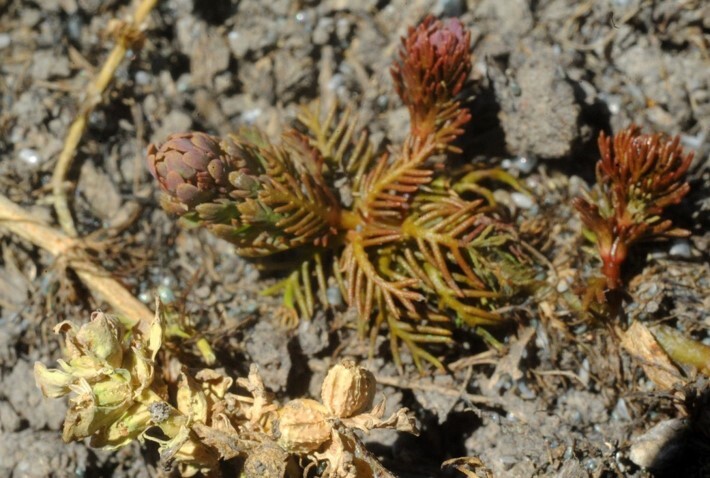Myriophyllum porcatum
Orchard Ridged Water-milfoilAnnual aquatic herb; stems 25–40 cm long, mostly 1–3 mm diam., rooting mainly at the base, emergent parts sparingly branched. Leaves dimorphic; submerged leaves in whorls of 4 or 5, broadly ovate, mostly 11–16 mm long, pectinate, with 10–18 pinnae; emergent leaves in whorls of 3–5, oblanceolate, mostly 5–6 mm long, glaucous, with 2–6 spreading lobes at base. Bracteoles linear, 0.8–1.6 mm long, entire or weakly toothed, cream; flowers solitary, sessile. Male flowers: sepals 4, orbicular, c. 0.1 mm long; petals 4, 1.4–1.5 mm long, yellow, red-tinted, caducous; stamens 8. Female flowers: sepals and petals absent; ovary 4-celled, styles clavate to conical, stigmas smooth, red. Fruit shortly cylindric, green-brown to reddish; mericarps cylindric, 1.8–2.1 mm long, with 3 longitudinal ridges, irregularly verrucose on dorsal surface. Flowers Sep.–Dec
LoM, MuM, VVP, VRiv, MuF, NIS. Rare and restricted to northern and north-western Victoria where it has been recorded growing in temporary waterholes, lagoons, farm dams and rock holes, and on clay pans.
This species is closely related to Myriophyllum caput-medusae, but is less robust, has a less branched inflorescence, all leaves whorled, smaller flowers, and larger fruits with different ornamentation (Orchard 1985).
Jeanes, J.A. (1996). Haloragaceae. In: Walsh, N.G.; Entwisle, T.J., Flora of Victoria Vol. 3, Dicotyledons Winteraceae to Myrtaceae, pp. 887–908. Inkata Press, Melbourne.
 Spinning
SpinningOrchard, A.E. (1985). Myriophyllum (Haloragaceae) in Australasia. II. The Australian Species. Brunonia 8: 173–291.

